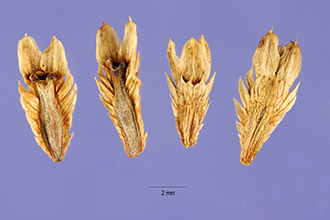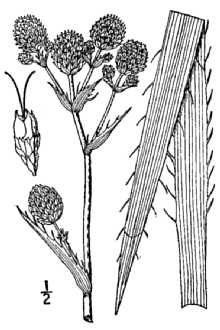Rattlesnakemaster
Scientific Name: Eryngium aquaticum L.

| General Information | |
|---|---|
| Usda Symbol | ERAQ |
| Group | Dicot |
| Life Cycle | Biennial |
| Growth Habits | Forb/herb |
| Native Locations | ERAQ |
Plant Guide
Alternate Names
Corn-snakeroot, bitter snakeroot, marsh eryngo, sea holly , Use soil moisture sensors to measure the soil moisture of Rattlesnakemaster.
Uses
Ethnobotanic: The Cherokee, Choctaw, Koasati and other Southwestern Native American tribes used a tea made from the plants to treat “stomach disorders.” The root was chewed for stomachache. An infusion, made from the roots, was used to cause vomiting for nausea, as a powerful expectorant to clear the lungs, and a diuretic. The root was used as a stimulant as well as an “anti-poison” to treat snakebite. The Choctaw used the plant to treat gonorrhea. The Alabama and Koasati tribes used the plant ceremonially as well as medicinally. The Koasati believed the plant to contain magical powers, which could kill an enemy merely by striking him with it. The roots are collected in the autumn. Some Native Americans still use the plant today. Other: The unique shape and color of rattlesnakemaster flower sprays make them an unusual addition to fresh and dried flower arrangements. For best results, cut the flowers before they open completely. @ PLANTS
Status
Please consult the PLANTS Web site and your State Department of Natural Resources for this plant’s current status (e.g. threatened or endangered species, state noxious status, and wetland indicator values).
Description
General: Carrot or parsley family (Apiaceae, formerly Umbelliferae). These hardy, perennial or biennial herbs, resembling a cross between a yucca and a thistle, can be a little over a meter to two meters tall. The solitary, erect stem has parallel ribs and branches near the top, ending in globe-shaped flowers. The stem has alternate leaves, which are narrow, lance-shaped and pinnately veined. The broad, stiff basal leaves (20-90cm long, 9cm wide), are usually absent at the time of flowering. Leaves can be slightly toothed along the edges. The plants flower from spring to fall. The white to blue flower heads are 1-1.5 cm with 2mm-long flower petals. Spiny, bluish, leaflike bracts extend beyond the flowering heads giving them an unusual appearance. Fruits are short and oblong, from 2 to 4mm, with scales. Distribution: For current distribution, please consult the Plant Profile page for this species on the PLANTS Web site. Habitat: The species grows in wet soils, along waters edges in fresh to brackish marshes, low woods, meadows, bogs, swamps and ditches.
Adaptation
E. aquaticum is adapted to marshy or seasonally flooded areas. It grows in soils that are regularly saturated to irregularly inundated.
Establishment
Both the sword-shaped foliage and the unusual flowers of Rattlesnakemaster make them a unique and beautiful sculptural addition to the garden. Plants may be propagated from seed or by transplanting purchased container-grown plants. To collect your own seeds, gather the flower heads after they have turned brown and dried upon the plant. Sow seeds in the fall. The plants like moist, rich, light soils in sunny locations. For heavy soils, add compost before planting. Take care to select a place where the plants can remain as the root system dislikes disturbance. The plants may be propagated by carefully divided them in the spring. Root cuttings can be taken in the winter.
Pests and Potential Problems
E. aquaticum is susceptible to tobacco mild green mosaic tobamovirus Cultivars, Improved, and Selected Materials (and area of origin) Most of the material cultured under this name is E. yuccifolium, which is adapted to drier habitats. These plant materials are somewhat available from commercial sources. Aquatic nurseries can be a good source for these plants. Contact your local Natural Resources
Conservation
Service (formerly Soil Conservation Service) office for more information. Look in the phone book under ”United States Government.” The Natural Resources Conservation Service will be listed under the subheading “Department of Agriculture.”

